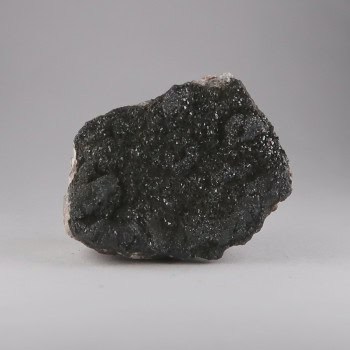Braunite
Braunite is a dark silvery-grey metallic mineral used as an ore of manganese – along with being a collectors specimen.
Showing the single result
Information about Braunite
Braunite is a manganese silicate mineral that typically forms as dark brown to black crystals or granular masses with a submetallic to dull luster.
Its crystals are often prismatic or tabular, though it more commonly appears in massive or granular habits.
Braunite is opaque and has a distinctive steel-gray to black streak. It is frequently associated with other manganese minerals in metamorphosed manganese-rich deposits.
A member of the Braunite group, which contains several other minerals:
- Abswurmbachite – CuMn3+6(SiO4)O8
- Braunite – Mn2+Mn3+6(SiO4)O8
- Braunite-II – CaMn3+14(SiO4)O20
- Gatedalite – ZrMn2+2Mn3+4SiO12
- Neltnerite – CaMn3+6(SiO4)O8
Uses and History
Braunite is an important ore of manganese, a critical element in steel production, batteries, and various chemical applications.
While it has industrial significance, it is also collected by mineral enthusiasts for its association with manganese-rich deposits and its unique crystal formations.
Braunite was first described in 1826 and was named in honor of Wilhelm von Braun, a German mining official and mineralogist.
It has since been studied extensively for its role in manganese ore deposits and its unique chemical composition, which includes both manganese(II) and manganese(III) in its structure.
Mineralogy
Brownish black, steel grey, black
Hazards and Warnings
Manganese exposure through dust is toxic but handling is relatively safe providing hands are washed.
Mineral collectors should wash their hands after handling specimens, to avoid any exposure to potential toxins.
Almost all rocks, minerals (and, frankly, almost all other substances on earth) can produce toxic dust when cutting, which can cause serious respiratory conditions including silicosis.
When cutting or polishing rocks, minerals, shells, etc, all work should be done wet to minimise the dust, and a suitable respirator or extraction system should be used.
Translations
Arabic:
Hindi:
Portuguese:
Bengali:
Indonesian:
Punjabi:
English:
- Braunite
Italian:
Russian:
- Браунит
French:
Japanese:
- ブラウン鉱
Spanish:
- Braunita
German:
- Braunit
Korean:
Thai:
Gujurati:
Mandarin Chinese:
- 褐锰矿
Urdu:

